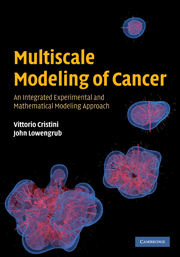Book contents
- Frontmatter
- Contents
- List of contributors
- Preface
- Acknowledgements
- Notation
- Part I Theory
- 1 Introduction
- 2 Biological background
- 3 Continuum tumor modeling: single phase
- 4 Analysis and calibration of single-phase continuum tumor models
- 5 Continuum tumor modeling: multiphase
- 6 Discrete cell modeling
- 7 Hybrid continuum–discrete tumor models
- 8 Numerical schemes
- Part II Applications
- References
- Index
7 - Hybrid continuum–discrete tumor models
from Part I - Theory
Published online by Cambridge University Press: 05 October 2010
- Frontmatter
- Contents
- List of contributors
- Preface
- Acknowledgements
- Notation
- Part I Theory
- 1 Introduction
- 2 Biological background
- 3 Continuum tumor modeling: single phase
- 4 Analysis and calibration of single-phase continuum tumor models
- 5 Continuum tumor modeling: multiphase
- 6 Discrete cell modeling
- 7 Hybrid continuum–discrete tumor models
- 8 Numerical schemes
- Part II Applications
- References
- Index
Summary
Recently, hybrid modeling techniques have been proposed that combine the advantages of the continuum and the discrete approaches in order to simulate multiscale multibody problems; these provide more realistic descriptions of microscopic mechanisms while efficiently evolving the entire system to obtain macroscopic observations. Solid-tumor growth is one example of such multiscale problems, where the cellular and subcellular scale pathways have been intensively studied and are fairly well understood while the tissue-scale tumor morphology is of interest in clinical applications. We presented a sharp-interface model in Chapter 3 and a Cahn–Hilliard mixture model in Chapter 5, using the continuum approach to simulate the tissue-scale macroscopic morphology of tumors. The dynamics of how tumor cells interact with the microenvironment were studied in Chapter 6 by formulating agent-based models at the cellular and subcellular scales using the discrete approach. By combining the continuum and the discrete approaches, we now present a hybrid modeling framework that utilizes knowledge collected at the cellular and subcellular scales in the study of tissue-scale tumor evolution. Figure 7.1 illustrates the basic components constituting a hybrid model; each component will be detailed in this chapter.
We first review, in Section 7.1, some earlier related work that led to the development of hybrid models. Next, in Section 7.2, we discuss how the fundamental conservation laws are used to establish the general concept of hybrid tumor models. Then the hybrid coupling mechanisms through mass and momentum exchange will be rigorously formulated in Section 7.3.
- Type
- Chapter
- Information
- Multiscale Modeling of CancerAn Integrated Experimental and Mathematical Modeling Approach, pp. 123 - 152Publisher: Cambridge University PressPrint publication year: 2010
- 2
- Cited by



